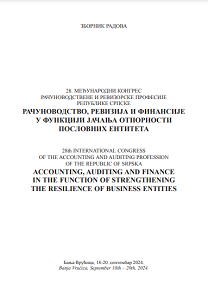ГРАНИЧНЕ РАЧУНОВОДСТВЕНЕ ИНФОРМАЦИЈЕ У ПРОЦЈЕНИ ОДРЖИВОСТИ ПОСЛОВАЊА
BOUNDARY ACCOUNTING INFORMATION IN THE ASSESSMENT OF BUSINESS SUSTAINABILITY
Author(s): Vinko Belak
Subject(s): Business Economy / Management, Accounting - Business Administration
Published by: Savez računovođa i revizora Republike Srpske
Keywords: sustainability; going concern; relationship between assets and liabilities; value of assets; amount of liabilities; significant doubt;
Summary/Abstract: In the framework of business sustainability assessment, it is usually assumed that the company will remain in business and that the value of its assets will last unless there is information to the contrary. However, the concept of going concern is not clearly and unequivocally defined in accounting and auditing standards. Because of this, there are different interpretations of this term, as well as different proposals about which indicators best indicate business sustainability. In this paper, another proposal is made in which the boundary accounting information is defined in the assessment of business sustainability, which could help auditors in making decisions. A loss is always a trigger for auditors to consider declaring significant doubt about the entity’s ability to continue as a going concern. However, a profit loss in one business year does not necessarily mean that the entity will cease to operate. That is why the auditor should make a more detailed analysis of the entity’s financial situation. This analysis should start with the calculation of whether the assets can cover the liabilities. Although it looks simple, it raises a number of difficult questions. First of all, the question is how much is the property really worth? Is the asset worth more than the book value or maybe it is worth less? If the asset is worth less, a write-down should be carried out first, which will further increase current profit losses. There is another problem here. If the asset will not be used further, the recoverable amount of the asset can drastically fall below the book value. In addition, the possibility of increasing liabilities in the event of a business interruption should also be assessed. Only after all these analyzes will it be possible to answer the question of whether the assets cover the liabilities, which enables the continuation of business.
- Page Range: 49-56
- Page Count: 8
- Publication Year: 2024
- Language: Serbian
- Content File-PDF

